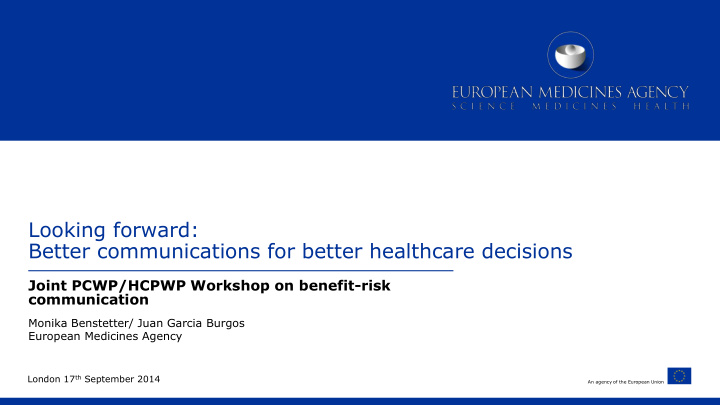



Looking forward: Better communications for better healthcare decisions Joint PCWP/HCPWP Workshop on benefit-risk communication Monika Benstetter/ Juan Garcia Burgos European Medicines Agency London 17 th September 2014 An agency of the European Union
The challenges 1
Our ambition To support the relationship between patients and healthcare professionals with effective benefit-risk communication: – it is largely used for their joint decisions on patient treatment. 2
Goals • Improve our communications on benefit-risk to patients and healthcare professionals • Consider new opportunities in a changing and fast-evolving environment • Make sure messages are used in healthcare, thereby contributing to people’s health 3
Measuring effectiveness of benefit-risk communication • Effective communication is when the message transmitted is received and understood by the target audience in the way it was intended, and the desired action is taken by the target audience. • The challenge: to be able to discriminate the impact of communications on overall change achieved – Some research available in the EU, in relation to DHPCs, with limited conclusions – SCOPE results awaited – Some examples considered: referral on CHCs 4
Measuring effectiveness of benefit-risk communication Principles for proposed way forward: Research-based approach & learning system • Measures Identify a list of indicators for ‘public health communications’ • - E.g. how well are messages reflected and understood in media coverage, - Use and dissemination of communications materials by concerned organisations - Subsequent communications by NCAs - Social media activity Collect and report systematically on these indicators • Identify and use other research tools, e.g. questionnaires to users, etc • Analyse and adapt tools and practices accordingly • 5
(Re-)Defining our target audience • Who do we want to reach? • Who can we really reach? • Audience research (stakeholder analyses): – gather information on requirements and expectations – assess current practice - what is working best – identify gaps and areas for improvement – incorporate audience profiling • Adapt communication strategies, practice and tools 6
Reaching out to the public • EMA relies on 3 key elements to reach a wider audience in the EU: – Relations within the EU Regulatory Network, – Relations with patients’ and healthcare professionals’ organisations, – Relations with media. • Intensify relations; make information more relevant; help disseminating important benefit-risk information on medicines. 7
Speaking the audience’s language • The EU’s complex language environment has considerably limited the reach of the EMA’s communications • Some key EMA information are published in all 23 official EU languages (e.g. EPAR summaries, product information, safety communications) - EMA has only had the capacity to mainly communicate in English (website navigation, press releases, etc only in English) • Recent European Ombudsman recommendations • Close operational coordination with the EU Regulatory Network and organisations is essential to help messages from the EMA penetrate beyond the immediate range of the EMA’s core stakeholder groups to reach important audiences in the Member States who ought to be more aware of EU recommendations on benefit-risk. 8
Adapting to the audience’s need – one size does not fit all • Feedback received from individual patients and healthcare professionals and independent research • Further develop tools which allow access to different levels of information by the different audiences: – Exploring the use of additional layer of information which is patient-friendlier in key communications on benefit-risk (e.g. safety communications, summary of each medicine, etc) 9
Offering information people are interested in A single point of reference for information about medicines in EU – In the future, the EU Medicines Web Portal 10
Using ‘their’ communication tools • Extend the use of social media, e.g. twitter, blogs, • Mobile communication technologies (use of smart phones, etc.) • Engage and interact in relevant online communities • Enhance provision of sharable content (multimedia content, infographics, etc) But keeping good balance with traditional media 11
Building knowledge of medicines development and regulation • Guarantee the educational element of benefit-risk communication: – As a fundamental element supporting the doctor – patient relation – Past and current positive initiatives in this area – Explore a more structured, comprehensive approach with involvement of patients and healthcare professionals 12
Communicating uncertainty • Benefit-risk profile of a medicine is a dynamic, evolving value • Moving towards earlier communication – where the public needs to accept and understand uncertain situations subject to external change (communication on signals, interim measures, crisis communication, etc) • Communicating uncertainties contributes to educating the public on how the regulatory system works and allows exploring its limitations • Ultimately, it helps building trust 13
Timing of benefit-risk communication • Earlier communication in response to increased public interest in medicines regulation (particularly related to safety aspects) • Benefit-risk communication is an on- going process throughout a medicine’s life: – More systematic communication at the time of authorisation: • More outspoken (providing relevant information while avoiding promotion) • Contextualise the value of a new marketing authorisation in the path to patient access 14
User testing of benefit-risk communications • Successful EMA initiative after 5 years of experience • Confirmed added value – Same level of feedback implementation as compared to other internal reviewers – Open channel for continuous dialogue with real users of our communication materials • Exploring further support to individual patients and healthcare professionals (training and financial) as confirmation of their added value 15
Re-building trust Trust level in government bodies is at record low. Build trust : Public health first • Consistent operations, processes and decisions • Really listen to stakeholders • Deal early with complicated issues and communicate promptly • Honest communication, coherent with actions • 16
Thank you for your attention
Recommend
More recommend